1 of 9
Download to read offline
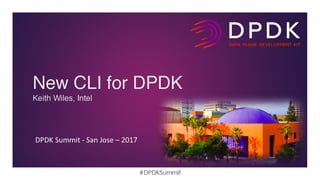
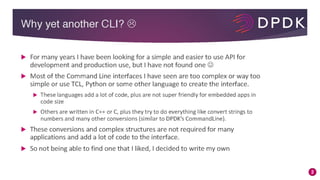
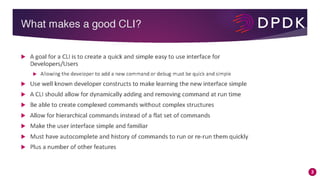

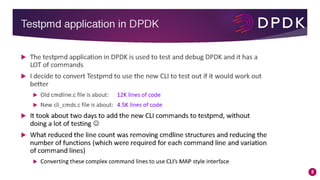

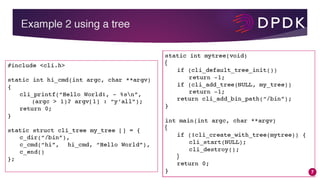
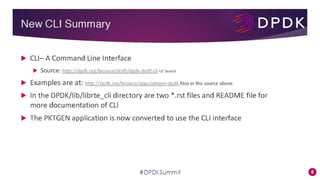
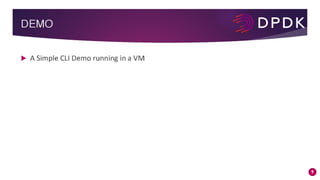
Ad
Recommended
LF_DPDK17_Event Adapters - Connecting Devices to Eventdev
LF_DPDK17_Event Adapters - Connecting Devices to EventdevLF_DPDK
╠²
This document discusses event adapters in DPDK, which interface devices like network cards and cryptodevices to the event device framework. It describes Ethernet Rx, crypto, and timer adapters. The Ethernet Rx adapter handles receiving packets from network cards and enqueueing events. The crypto adapter supports enqueueing crypto operation events. The timer adapter provides a way to arm timers that generate expiry events. Event adapters provide common APIs and allow devices to produce events that are consumed by DPDK components running on multiple processor cores.LF_DPDK17_Integrating and using DPDK with Open vSwitch
LF_DPDK17_Integrating and using DPDK with Open vSwitchLF_DPDK
╠²
The document discusses the challenges of integrating DPDK with Open vSwitch and the approaches taken to address them. Some key challenges included DPDK's preference for its own data structures, initialization requirements, threading model differences, and debugging difficulties. The integration addresses these by allowing Open vSwitch to maintain its own data structures and threading while initializing DPDK, and improving configuration, PMD support, and documentation for debugging. Upgrades remain challenging due to DPDK's API and ABI changes.LF_DPDK17_ OpenVswitch hardware offload over DPDK
LF_DPDK17_ OpenVswitch hardware offload over DPDKLF_DPDK
╠²
This document discusses Mellanox Technologies' work on hardware offloading for Open vSwitch using DPDK. It describes concepts for using hardware classification offloading to accelerate Open vSwitch by offloading flow rules and classification to the NIC. It provides examples of performance improvements seen from using hardware classification offloading for Open vSwitch workloads. It also discusses approaches for using multi-table classification and hardware offloading for VxLAN encapsulation and decapsulation in Open vSwitch.LF_DPDK17_DPDK support for new hardware offloads
LF_DPDK17_DPDK support for new hardware offloadsLF_DPDK
╠²
This document discusses DPDK support for new hardware offloads. It describes the Netronome Agilio SmartNIC card, which has hardware accelerators and can offload tasks like cryptography and flow processing. It discusses using the card with OVS-DPDK for improved performance over kernel OVS. Full offloading of OVS classification and actions to the NIC is proposed to reduce CPU usage. Supporting eBPF offloading is also discussed, as is using DPDK with virtio. Overall the document explores how DPDK can better leverage network hardware offloads.LF_DPDK17_DPDK's best kept secret ŌĆō Micro-benchmark performance tests
LF_DPDK17_DPDK's best kept secret ŌĆō Micro-benchmark performance testsLF_DPDK
╠²
DPDK's micro-benchmarks are important to run prior to application development and benchmarking. They quantitatively measure the performance of key high performance objects and operations in DPDK like rings, memory pools, mbufs, and functions like memory copying and hashing. This helps optimize the system configuration and ensures cores and devices are allocated optimally across sockets before developing applications. The document demonstrates some examples of DPDK micro-benchmarks and encourages attendees to find and use them to build a strong performance foundation.LF_DPDK17_Lagopus Router
LF_DPDK17_Lagopus RouterLF_DPDK
╠²
The Lagopus Router is a modular, open-source software router developed by the Lagopus Project. It is written in C and Golang for high performance packet processing using DPDK. The router has a modular architecture that provides high extensibility for handling network protocols. Current supported protocols include L2, L3, tunneling and IPsec. The goal of the project is to develop an open-source, high performance software router that supports many protocols and can be customized for various network functions and services.LF_DPDK17_DPDK Membership Library
LF_DPDK17_DPDK Membership LibraryLF_DPDK
╠²
The DPDK Membership Library provides functionality for creating set summaries that allow for fast membership testing of elements in large sets. It was introduced in DPDK 17.11. The library supports different data structures like Bloom filters and cuckoo filters that provide probabilistic membership queries while using less storage than storing the entire set. The Membership Library API allows for creating summaries, adding/deleting elements, and single or bulk lookup queries. An example use is to improve performance of Open vSwitch flow table lookups using the library to direct flows to specific sub-tables.LF_DPDK17_Accelerating NFV with VMware's Enhanced Network Stack (ENS) and Int...
LF_DPDK17_Accelerating NFV with VMware's Enhanced Network Stack (ENS) and Int...LF_DPDK
╠²
This document discusses accelerating network function virtualization (NFV) with VMware's Enhanced Networking Stack (ENS) and Intel's Poll Mode Drivers (PMD). ENS is a new, faster networking stack for vSphere targeted at NFV applications that employs DPDK techniques. It includes a new vmxnet3 virtual device backend, new poll-mode physical device drivers from Intel, and faster switching using flow caching. Testing showed ENS provides a 3-5x improvement in packet rate over the existing vSphere networking stack, with acceptable packet loss and low latency.LF_DPDK17_Make DPDK's software traffic manager a deployable solution for vBNG
LF_DPDK17_Make DPDK's software traffic manager a deployable solution for vBNGLF_DPDK
╠²
DPDK Summit in San Jose 2017 focused on making DPDK's software traffic manager a deployable solution for virtual Broadband Network Gateway (vBNG). The presentation aimed to discuss DPDK's software traffic manager and how it could be used as a virtual BNG solution. The goal was to provide a 3 sentence or less high-level summary of the key information and purpose from the document.LF_DPDK17_OpenNetVM: A high-performance NFV platforms to meet future communic...
LF_DPDK17_OpenNetVM: A high-performance NFV platforms to meet future communic...LF_DPDK
╠²
This document discusses software-based networking and network function virtualization (NFV). It introduces NetVM, an NFV platform developed by the author that provides high performance packet delivery across virtual machines using DPDK for zero-copy networking. NetVM enables complex network services to be distributed across multiple VMs while maintaining high throughput. The author also discusses OpenNetVM, an open source version of NetVM, and contributions like Flurries that enable unique network functions to run per flow for improved scalability. NFVnice, a userspace framework for scheduling NFV chains, is also introduced to improve throughput, fairness and CPU utilization.LF_DPDK17_DPDK on Microsoft Azure
LF_DPDK17_DPDK on Microsoft AzureLF_DPDK
╠²
Microsoft is working to support DPDK on the Azure cloud platform to improve performance for network functions virtualization (NFV) workloads. Azure now offers accelerated networking which provides single-root I/O virtualization and can achieve throughputs over 30Gbps. Microsoft has enhanced DPDK to enable serviceability features like live migration and driver updates while keeping the DPDK application transparent. A public preview of DPDK-enabled VMs has been launched in the Canada East region, with the goal of expanding availability and improving migration transparency with community feedback.LF_DPDK17_Accelerating Packet Processing with FPGA NICs
LF_DPDK17_Accelerating Packet Processing with FPGA NICsLF_DPDK
╠²
The document discusses accelerating packet processing with FPGA NICs using generic inline acceleration. It proposes a framework where a NIC can support multiple Inline Acceleration Functional Units (I-AFUs) from different vendors. Any packet flow could then be redirected to any I-AFU for application-specific processing. The framework would provide discovery of I-AFUs on a NIC, control and configuration of I-AFUs, and ability to steer packets to I-AFUs using new "call accelerator" actions in the DPDK flow API. This would allow flexible offloading of packet processing tasks to I-AFUs programmed in the field without modifying the packet processing data path.LF_DPDK17_rte_security: enhancing IPSEC offload
LF_DPDK17_rte_security: enhancing IPSEC offload LF_DPDK
╠²
This document describes rte_security, a framework for enabling hardware acceleration of security protocols like IPsec in DPDK. It provides a generic API to manage security sessions and interfaces with crypto and Ethernet devices. Currently it supports inline crypto acceleration and lookaside protocol acceleration. The framework is protocol-agnostic and aims to support additional protocols like SSL, PDCP, and CAPWAP. It allows applications to leverage different security accelerations through a common API.LF_DPDK17_Enabling hardware acceleration in DPDK data plane applications
LF_DPDK17_Enabling hardware acceleration in DPDK data plane applicationsLF_DPDK
╠²
This document discusses hardware acceleration models for DPDK data plane applications, including lookaside, inline, and full pipeline models. It provides examples of using these models to accelerate IPsec processing via crypto or protocol acceleration. Key considerations for using hardware acceleration include understanding the impact on the application architecture and pipeline, whether the accelerator supports all scenarios or exceptions must be handled in software, and any restrictions placed on the application. Metadata propagation is important to allow applications to determine if packets have been accelerated or not and support hybrid solutions.LF_DPDK17_Serverless DPDK - How SmartNIC resident DPDK Accelerates Packet Pro...
LF_DPDK17_Serverless DPDK - How SmartNIC resident DPDK Accelerates Packet Pro...LF_DPDK
╠²
This document discusses smart network interface cards (NICs) and how using the Data Plane Development Kit (DPDK) framework can help accelerate next generation smartNICs. It provides an overview of smartNIC capabilities, market projections showing growth, and challenges with current smartNIC designs. The document proposes using DPDK as the networking dataplane for smartNICs to simplify deployment, improve performance when offloading tasks like Open vSwitch, and foster an open ecosystem similar to how DPDK is widely used on CPUs today. Key benefits discussed include DPDK being proven, supporting majority of networking applications, and its potential to accelerate when used on ARM-based smartNIC processors.LF_DPDK17_Flexible and Extensible support for new protocol processing with DP...
LF_DPDK17_Flexible and Extensible support for new protocol processing with DP...LF_DPDK
╠²
This document discusses dynamic device personalization (DDP) using Intel Ethernet 700 Series network cards. DDP allows run-time updating and configuration of the parse graph to expand or modify protocol support. This enables identification and processing of new protocols like MPLSoGRE, GTP-U/GTP-C, and QUIC without requiring a reboot. DPDK APIs allow downloading DDP profiles to enable parsing of additional protocols and configuring traffic steering based on tunnel IDs. With DDP, encapsulated frame fields can be extracted and used for functions like RSS, whereas without DDP those protocols would not be recognized.LF_DPDK17_rte_raw_device: implementing programmable accelerators using generi...
LF_DPDK17_rte_raw_device: implementing programmable accelerators using generi...LF_DPDK
╠²
Hemant Agrawal and Shreyansh Jain of NXP presented on implementing a generic "rawdevice" in DPDK to provide a uniform programming interface for accelerators and programmable devices. A rawdevice would allow any non-standard device to integrate with DPDK through common APIs for configuration, queue management, and data transfer without requiring a customized library for each new device type. The presentation provided motivation, definitions, and an example usage of layering a wireless baseband device driver on top of the proposed rawdevice interface.LF_DPDK17_Technical Roadmap
LF_DPDK17_Technical RoadmapLF_DPDK
╠²
The document provides an introduction to the DPDK Technical Board and repository maintainers. It discusses that the Technical Board was created in 2013 to allow trusted contributors to make technical decisions on behalf of the community. The current 9 members of the Technical Board are then listed. The document outlines the roles and responsibilities of the Technical Board, which include approving new functionality, libraries, maintainers, and subprojects. It also provides details on the DPDK release process, tools, repositories, intellectual property policy, and upcoming roadmap.LF_DPDK_Mellanox bifurcated driver model
LF_DPDK_Mellanox bifurcated driver modelLF_DPDK
╠²
The Mellanox PMD allows DPDK applications to directly access Mellanox NICs using the Raw Ethernet Accelerated Verbs API from libibverbs. It provides a fast data path while the kernel still controls the NIC and handles the control plane. Unlike other PMDs, the Mellanox PMD is a separate userspace application. Multiple DPDK applications can also run on a single Mellanox device and steer traffic between each other and the kernel without needing SR-IOV.LF_DPDK17_Abstract APIs for DPDK and ODP
LF_DPDK17_Abstract APIs for DPDK and ODPLF_DPDK
╠²
This document discusses abstract interfaces, APIs, and implementations for network functions like IPsec. It proposes a common Network Application Interface to provide hardware independence and allow live migration of virtual network functions between platforms with and without acceleration. This interface could be realized by both the Open Data Plane (ODP) and DPDK APIs/implementations to unify their approaches for network functions like IPsec processing.LF_DPDK17_DPDK with KNI ŌĆō Pushing the Performance of an SDWAN Gateway to High...
LF_DPDK17_DPDK with KNI ŌĆō Pushing the Performance of an SDWAN Gateway to High...LF_DPDK
╠²
The document outlines a presentation on using DPDK with KNI to improve the performance of an SD-WAN gateway. It discusses:
- Understanding typical SD-WAN ecosystems and gateway requirements
- How kernel-based forwarding has limitations that prevent meeting performance needs
- How DPDK can help by allowing dedicated resources and bypassing kernel processing
- The solution of using a dedicated DPDK application with KNI to leverage both DPDK and kernel functionality
- Details on the software architecture, component design, and how security and configuration are managedLF_DPDK17_mediated devices: better userland IO
LF_DPDK17_mediated devices: better userland IOLF_DPDK
╠²
This document discusses mediated devices and the net-mdev framework for allowing direct userspace access to network devices via VFIO. It aims to provide an alternative to kernel device drivers by allowing packet processing frameworks like DPDK and ODP to control devices from userspace. The net-mdev architecture involves a userspace library communicating with kernel drivers via netlink to setup descriptor rings and handle interrupts. An implementation for Realtek and Intel NICs showed driver changes of under 100 lines of code were needed. Further work is needed to finalize the vfio-mdev integration and handle issues with IOMMU groups and PCI mapping boundaries when porting multiple devices. The document proposes completing an understanding of the problem space and collaborLF_DPDK17_Enhanced Memory Management
LF_DPDK17_Enhanced Memory ManagementLF_DPDK
╠²
This document discusses challenges with DPDK's current memory management and proposes an enhanced memory manager framework. The current approach has limitations like static allocation, reliance on physical memory information, and lack of virtual addressing and isolation between processes. The proposal introduces a named memory partition concept to provide access control, placement control, isolation and protection between processes. It suggests DPDK act as a user of these memory domains to gain flexibility, performance tuning and support for different environments like containers and VMs.LF_DPDK17_SafetyOrange - a tiny server class multi-purpose box with DPDK
LF_DPDK17_SafetyOrange - a tiny server class multi-purpose box with DPDKLF_DPDK
╠²
This document summarizes an experiment using a backpack-sized DPDK development and test environment. The objectives were to demonstrate eliminating packet processing impacts of virtualization, create a portable "virtual router on a pendrive" proof of concept, and provide an efficient and affordable standalone DPDK environment. The hardware included a mini-ITX motherboard, Intel Xeon CPU, 32GB memory, and two X710 NICs enabled via PCIe bifurcation. Testing showed the environment could process over 10 Gbps of traffic while consuming around 111 watts of power, comparable to a desktop computer.LF_DPDK17_Implementation and Testing of Soft Patch Panel
LF_DPDK17_Implementation and Testing of Soft Patch PanelLF_DPDK
╠²
The document presents Soft Patch Panel (SPP), a framework for dynamic service function chaining. SPP consists of a resource manager and worker processes that can update network configurations without terminating services. SPP aims to provide flexibility, maintainability, and high performance for large-scale cloud services. Performance tests show SPP can achieve throughput comparable to OVS-DPDK and SR-IOV for packet forwarding. SPP VF emulates SR-IOV functionality and reduces dependency on specific hardware. An OpenStack plugin is being developed to integrate SPP VF with Neutron ML2.10 Key Challenges for AI within the EU Data Protection Framework.pdf
10 Key Challenges for AI within the EU Data Protection Framework.pdfPriyanka Aash
╠²
10 Key Challenges for AI within the EU Data Protection FrameworkTechniques for Automatic Device Identification and Network Assignment.pdf
Techniques for Automatic Device Identification and Network Assignment.pdfPriyanka Aash
╠²
Techniques for Automatic Device Identification and Network AssignmentMore Related Content
More from LF_DPDK (20)
LF_DPDK17_Make DPDK's software traffic manager a deployable solution for vBNG
LF_DPDK17_Make DPDK's software traffic manager a deployable solution for vBNGLF_DPDK
╠²
DPDK Summit in San Jose 2017 focused on making DPDK's software traffic manager a deployable solution for virtual Broadband Network Gateway (vBNG). The presentation aimed to discuss DPDK's software traffic manager and how it could be used as a virtual BNG solution. The goal was to provide a 3 sentence or less high-level summary of the key information and purpose from the document.LF_DPDK17_OpenNetVM: A high-performance NFV platforms to meet future communic...
LF_DPDK17_OpenNetVM: A high-performance NFV platforms to meet future communic...LF_DPDK
╠²
This document discusses software-based networking and network function virtualization (NFV). It introduces NetVM, an NFV platform developed by the author that provides high performance packet delivery across virtual machines using DPDK for zero-copy networking. NetVM enables complex network services to be distributed across multiple VMs while maintaining high throughput. The author also discusses OpenNetVM, an open source version of NetVM, and contributions like Flurries that enable unique network functions to run per flow for improved scalability. NFVnice, a userspace framework for scheduling NFV chains, is also introduced to improve throughput, fairness and CPU utilization.LF_DPDK17_DPDK on Microsoft Azure
LF_DPDK17_DPDK on Microsoft AzureLF_DPDK
╠²
Microsoft is working to support DPDK on the Azure cloud platform to improve performance for network functions virtualization (NFV) workloads. Azure now offers accelerated networking which provides single-root I/O virtualization and can achieve throughputs over 30Gbps. Microsoft has enhanced DPDK to enable serviceability features like live migration and driver updates while keeping the DPDK application transparent. A public preview of DPDK-enabled VMs has been launched in the Canada East region, with the goal of expanding availability and improving migration transparency with community feedback.LF_DPDK17_Accelerating Packet Processing with FPGA NICs
LF_DPDK17_Accelerating Packet Processing with FPGA NICsLF_DPDK
╠²
The document discusses accelerating packet processing with FPGA NICs using generic inline acceleration. It proposes a framework where a NIC can support multiple Inline Acceleration Functional Units (I-AFUs) from different vendors. Any packet flow could then be redirected to any I-AFU for application-specific processing. The framework would provide discovery of I-AFUs on a NIC, control and configuration of I-AFUs, and ability to steer packets to I-AFUs using new "call accelerator" actions in the DPDK flow API. This would allow flexible offloading of packet processing tasks to I-AFUs programmed in the field without modifying the packet processing data path.LF_DPDK17_rte_security: enhancing IPSEC offload
LF_DPDK17_rte_security: enhancing IPSEC offload LF_DPDK
╠²
This document describes rte_security, a framework for enabling hardware acceleration of security protocols like IPsec in DPDK. It provides a generic API to manage security sessions and interfaces with crypto and Ethernet devices. Currently it supports inline crypto acceleration and lookaside protocol acceleration. The framework is protocol-agnostic and aims to support additional protocols like SSL, PDCP, and CAPWAP. It allows applications to leverage different security accelerations through a common API.LF_DPDK17_Enabling hardware acceleration in DPDK data plane applications
LF_DPDK17_Enabling hardware acceleration in DPDK data plane applicationsLF_DPDK
╠²
This document discusses hardware acceleration models for DPDK data plane applications, including lookaside, inline, and full pipeline models. It provides examples of using these models to accelerate IPsec processing via crypto or protocol acceleration. Key considerations for using hardware acceleration include understanding the impact on the application architecture and pipeline, whether the accelerator supports all scenarios or exceptions must be handled in software, and any restrictions placed on the application. Metadata propagation is important to allow applications to determine if packets have been accelerated or not and support hybrid solutions.LF_DPDK17_Serverless DPDK - How SmartNIC resident DPDK Accelerates Packet Pro...
LF_DPDK17_Serverless DPDK - How SmartNIC resident DPDK Accelerates Packet Pro...LF_DPDK
╠²
This document discusses smart network interface cards (NICs) and how using the Data Plane Development Kit (DPDK) framework can help accelerate next generation smartNICs. It provides an overview of smartNIC capabilities, market projections showing growth, and challenges with current smartNIC designs. The document proposes using DPDK as the networking dataplane for smartNICs to simplify deployment, improve performance when offloading tasks like Open vSwitch, and foster an open ecosystem similar to how DPDK is widely used on CPUs today. Key benefits discussed include DPDK being proven, supporting majority of networking applications, and its potential to accelerate when used on ARM-based smartNIC processors.LF_DPDK17_Flexible and Extensible support for new protocol processing with DP...
LF_DPDK17_Flexible and Extensible support for new protocol processing with DP...LF_DPDK
╠²
This document discusses dynamic device personalization (DDP) using Intel Ethernet 700 Series network cards. DDP allows run-time updating and configuration of the parse graph to expand or modify protocol support. This enables identification and processing of new protocols like MPLSoGRE, GTP-U/GTP-C, and QUIC without requiring a reboot. DPDK APIs allow downloading DDP profiles to enable parsing of additional protocols and configuring traffic steering based on tunnel IDs. With DDP, encapsulated frame fields can be extracted and used for functions like RSS, whereas without DDP those protocols would not be recognized.LF_DPDK17_rte_raw_device: implementing programmable accelerators using generi...
LF_DPDK17_rte_raw_device: implementing programmable accelerators using generi...LF_DPDK
╠²
Hemant Agrawal and Shreyansh Jain of NXP presented on implementing a generic "rawdevice" in DPDK to provide a uniform programming interface for accelerators and programmable devices. A rawdevice would allow any non-standard device to integrate with DPDK through common APIs for configuration, queue management, and data transfer without requiring a customized library for each new device type. The presentation provided motivation, definitions, and an example usage of layering a wireless baseband device driver on top of the proposed rawdevice interface.LF_DPDK17_Technical Roadmap
LF_DPDK17_Technical RoadmapLF_DPDK
╠²
The document provides an introduction to the DPDK Technical Board and repository maintainers. It discusses that the Technical Board was created in 2013 to allow trusted contributors to make technical decisions on behalf of the community. The current 9 members of the Technical Board are then listed. The document outlines the roles and responsibilities of the Technical Board, which include approving new functionality, libraries, maintainers, and subprojects. It also provides details on the DPDK release process, tools, repositories, intellectual property policy, and upcoming roadmap.LF_DPDK_Mellanox bifurcated driver model
LF_DPDK_Mellanox bifurcated driver modelLF_DPDK
╠²
The Mellanox PMD allows DPDK applications to directly access Mellanox NICs using the Raw Ethernet Accelerated Verbs API from libibverbs. It provides a fast data path while the kernel still controls the NIC and handles the control plane. Unlike other PMDs, the Mellanox PMD is a separate userspace application. Multiple DPDK applications can also run on a single Mellanox device and steer traffic between each other and the kernel without needing SR-IOV.LF_DPDK17_Abstract APIs for DPDK and ODP
LF_DPDK17_Abstract APIs for DPDK and ODPLF_DPDK
╠²
This document discusses abstract interfaces, APIs, and implementations for network functions like IPsec. It proposes a common Network Application Interface to provide hardware independence and allow live migration of virtual network functions between platforms with and without acceleration. This interface could be realized by both the Open Data Plane (ODP) and DPDK APIs/implementations to unify their approaches for network functions like IPsec processing.LF_DPDK17_DPDK with KNI ŌĆō Pushing the Performance of an SDWAN Gateway to High...
LF_DPDK17_DPDK with KNI ŌĆō Pushing the Performance of an SDWAN Gateway to High...LF_DPDK
╠²
The document outlines a presentation on using DPDK with KNI to improve the performance of an SD-WAN gateway. It discusses:
- Understanding typical SD-WAN ecosystems and gateway requirements
- How kernel-based forwarding has limitations that prevent meeting performance needs
- How DPDK can help by allowing dedicated resources and bypassing kernel processing
- The solution of using a dedicated DPDK application with KNI to leverage both DPDK and kernel functionality
- Details on the software architecture, component design, and how security and configuration are managedLF_DPDK17_mediated devices: better userland IO
LF_DPDK17_mediated devices: better userland IOLF_DPDK
╠²
This document discusses mediated devices and the net-mdev framework for allowing direct userspace access to network devices via VFIO. It aims to provide an alternative to kernel device drivers by allowing packet processing frameworks like DPDK and ODP to control devices from userspace. The net-mdev architecture involves a userspace library communicating with kernel drivers via netlink to setup descriptor rings and handle interrupts. An implementation for Realtek and Intel NICs showed driver changes of under 100 lines of code were needed. Further work is needed to finalize the vfio-mdev integration and handle issues with IOMMU groups and PCI mapping boundaries when porting multiple devices. The document proposes completing an understanding of the problem space and collaborLF_DPDK17_Enhanced Memory Management
LF_DPDK17_Enhanced Memory ManagementLF_DPDK
╠²
This document discusses challenges with DPDK's current memory management and proposes an enhanced memory manager framework. The current approach has limitations like static allocation, reliance on physical memory information, and lack of virtual addressing and isolation between processes. The proposal introduces a named memory partition concept to provide access control, placement control, isolation and protection between processes. It suggests DPDK act as a user of these memory domains to gain flexibility, performance tuning and support for different environments like containers and VMs.LF_DPDK17_SafetyOrange - a tiny server class multi-purpose box with DPDK
LF_DPDK17_SafetyOrange - a tiny server class multi-purpose box with DPDKLF_DPDK
╠²
This document summarizes an experiment using a backpack-sized DPDK development and test environment. The objectives were to demonstrate eliminating packet processing impacts of virtualization, create a portable "virtual router on a pendrive" proof of concept, and provide an efficient and affordable standalone DPDK environment. The hardware included a mini-ITX motherboard, Intel Xeon CPU, 32GB memory, and two X710 NICs enabled via PCIe bifurcation. Testing showed the environment could process over 10 Gbps of traffic while consuming around 111 watts of power, comparable to a desktop computer.LF_DPDK17_Implementation and Testing of Soft Patch Panel
LF_DPDK17_Implementation and Testing of Soft Patch PanelLF_DPDK
╠²
The document presents Soft Patch Panel (SPP), a framework for dynamic service function chaining. SPP consists of a resource manager and worker processes that can update network configurations without terminating services. SPP aims to provide flexibility, maintainability, and high performance for large-scale cloud services. Performance tests show SPP can achieve throughput comparable to OVS-DPDK and SR-IOV for packet forwarding. SPP VF emulates SR-IOV functionality and reduces dependency on specific hardware. An OpenStack plugin is being developed to integrate SPP VF with Neutron ML2.Recently uploaded (20)
10 Key Challenges for AI within the EU Data Protection Framework.pdf
10 Key Challenges for AI within the EU Data Protection Framework.pdfPriyanka Aash
╠²
10 Key Challenges for AI within the EU Data Protection FrameworkTechniques for Automatic Device Identification and Network Assignment.pdf
Techniques for Automatic Device Identification and Network Assignment.pdfPriyanka Aash
╠²
Techniques for Automatic Device Identification and Network AssignmentUsing the SQLExecutor for Data Quality Management: aka One man's love for the...
Using the SQLExecutor for Data Quality Management: aka One man's love for the...Safe Software
╠²
The SQLExecutor is one of FMEŌĆÖs most powerful and flexible transformers. Pivvot maintains a robust internal metadata hierarchy used to support ingestion and curation of thousands of external data sources that must be managed for quality before entering our platform. By using the SQLExecutor, Pivvot can efficiently detect problems and perform analysis before data is extracted from our staging environment, removing the need for rollbacks or cycles waisted on a failed job. This presentation will walk through three distinct examples of how Pivvot uses the SQLExecutor to engage its metadata hierarchy and integrate with its Data Quality Management workflows efficiently and within the source postgres database. Spatial Validation ŌĆōValidating spatial prerequisites before entering a production environment. Reference Data Validation - Dynamically validate domain-ed columns across any table and multiple columns per table. Practical De-duplication - Removing identical or near-identical well point locations from two distinct source datasets in the same table."Scaling in space and time with Temporal", Andriy Lupa.pdf
"Scaling in space and time with Temporal", Andriy Lupa.pdfFwdays
╠²
Design patterns like Event Sourcing and Event Streaming have long become standards for building real-time analytics systems. However, when the system load becomes nonlinear with fast and often unpredictable spikes, it's crucial to respond quickly in order not to lose real-time operating itself.
In this talk, IŌĆÖll share my experience implementing and using a tool like Temporal.io. We'll explore the evolution of our system for maintaining real-time report generation and discuss how we use Temporal both for short-lived pipelines and long-running background tasks.Security Tips for Enterprise Azure Solutions
Security Tips for Enterprise Azure SolutionsMichele Leroux Bustamante
╠²
Delivering solutions to Azure may involve a variety of architecture patterns involving your applications, APIs data and associated Azure resources that comprise the solution. This session will use reference architectures to illustrate the security considerations to protect your Azure resources and data, how to achieve Zero Trust, and why it matters. Topics covered will include specific security recommendations for types Azure resources and related network security practices. The goal is to give you a breadth of understanding as to typical security requirements to meet compliance and security controls in an enterprise solution.CapCut Pro Crack For PC Latest Version {Fully Unlocked} 2025
CapCut Pro Crack For PC Latest Version {Fully Unlocked} 2025pcprocore
╠²
¤æēØŚĪØŚ╝ØśüØŚ▓:ØŚ¢ØŚ╝ØŚĮØśå ØŚ╣ØŚČØŚ╗ØŚĖ & ØŚĮØŚ«ØśĆØśüØŚ▓ ØŚČØŚ╗ØśüØŚ╝ ØŚÜØŚ╝ØŚ╝ØŚ┤ØŚ╣ØŚ▓ ØŚ╗ØŚ▓Øśä ØśüØŚ«ØŚ»> https://pcprocore.com/ ¤æłŌŚĆ
CapCut Pro Crack is a powerful tool that has taken the digital world by storm, offering users a fully unlocked experience that unleashes their creativity. With its user-friendly interface and advanced features, itŌĆÖs no wonder why aspiring videographers are turning to this software for their projects.Oh, the Possibilities - Balancing Innovation and Risk with Generative AI.pdf
Oh, the Possibilities - Balancing Innovation and Risk with Generative AI.pdfPriyanka Aash
╠²
Oh, the Possibilities - Balancing Innovation and Risk with Generative AIMastering AI Workflows with FME by Mark Do╠łring
Mastering AI Workflows with FME by Mark Do╠łringSafe Software
╠²
Harness the full potential of AI with FME: From creating high-quality training data to optimizing models and utilizing results, FME supports every step of your AI workflow. Seamlessly integrate a wide range of models, including those for data enhancement, forecasting, image and object recognition, and large language models. Customize AI models to meet your exact needs with FMEŌĆÖs powerful tools for training, optimization, and seamless integrationPyCon SG 25 - Firecracker Made Easy with Python.pdf
PyCon SG 25 - Firecracker Made Easy with Python.pdfMuhammad Yuga Nugraha
╠²
Explore the ease of managing Firecracker microVM with the firecracker-python. In this session, I will introduce the basics of Firecracker microVM and demonstrate how this custom SDK facilitates microVM operations easily. We will delve into the design and development process behind the SDK, providing a behind-the-scenes look at its creation and features. While traditional Firecracker SDKs were primarily available in Go, this module brings a simplicity of Python to the table.The Growing Value and Application of FME & GenAI
The Growing Value and Application of FME & GenAISafe Software
╠²
With the cost of using Generative AI services dropping exponentially and the array of available models continually expanding, integrating AI into FME workflows has become inexpensive, accessible and effective. This presentation explores how GenAI within FME can cost-effectively transform data workflows by automating data extraction, validation, classification and augmentation tasks. WeŌĆÖll discuss how FMEŌĆÖs no-code flexibility enables users to combine Generative AI and Computer Vision tools that create efficient workflows tailored to specific challenges. Using recent practical examples, weŌĆÖll demonstrate how these integrations can simplify complex tasks, save time and enhance data quality.2025_06_18 - OpenMetadata Community Meeting.pdf
2025_06_18 - OpenMetadata Community Meeting.pdfOpenMetadata
╠²
The community meetup was held Wednesday June 18, 2025 @ 9:00 AM PST.
Catch the next OpenMetadata Community Meetup @ https://www.meetup.com/openmetadata-meetup-group/
In this month's OpenMetadata Community Meetup, "Enforcing Quality & SLAs with OpenMetadata Data Contracts," we covered data contracts, why they matter, and how to implement them in OpenMetadata to increase the quality of your data assets!
Agenda Highlights:
¤æŗ Introducing Data Contracts: An agreement between data producers and consumers
¤ōØ Data Contracts key components: Understanding a contract and its purpose
¤¦æŌĆŹ¤Ä© Writing your first contract: How to create your own contracts in OpenMetadata
¤”Š An OpenMetadata MCP Server update!
Ō×Ģ And More!WebdriverIO & JavaScript: The Perfect Duo for Web Automation
WebdriverIO & JavaScript: The Perfect Duo for Web Automationdigitaljignect
╠²
In todayŌĆÖs dynamic digital landscape, ensuring the quality and dependability of web applications is essential. While Selenium has been a longstanding solution for automating browser tasks, the integration of WebdriverIO (WDIO) with Selenium and JavaScript marks a significant advancement in automation testing. WDIO enhances the testing process by offering a robust interface that improves test creation, execution, and management. This amalgamation capitalizes on the strengths of both tools, leveraging SeleniumŌĆÖs broad browser support and WDIOŌĆÖs modern, efficient approach to test automation. As automation testing becomes increasingly vital for faster development cycles and superior software releases, WDIO emerges as a versatile framework, particularly potent when paired with JavaScript, making it a preferred choice for contemporary testing teams.Quantum AI Discoveries: Fractal Patterns Consciousness and Cyclical Universes
Quantum AI Discoveries: Fractal Patterns Consciousness and Cyclical UniversesSaikat Basu
╠²
Embark on a cosmic journey exploring the intersection of quantum
computing, consciousness, and ancient wisdom. Together we'll uncover the
recursive patterns that bind our reality.9-1-1 Addressing: End-to-End Automation Using FME
9-1-1 Addressing: End-to-End Automation Using FMESafe Software
╠²
This session will cover a common use case for local and state/provincial governments who create and/or maintain their 9-1-1 addressing data, particularly address points and road centerlines. In this session, you'll learn how FME has helped Shelby County 9-1-1 (TN) automate the 9-1-1 addressing process; including automatically assigning attributes from disparate sources, on-the-fly QAQC of said data, and reporting. The FME logic that this presentation will cover includes: Table joins using attributes and geometry, Looping in custom transformers, Working with lists and Change detection.ŌĆ£MPU+: A Transformative Solution for Next-Gen AI at the Edge,ŌĆØ a Presentation...
ŌĆ£MPU+: A Transformative Solution for Next-Gen AI at the Edge,ŌĆØ a Presentation...Edge AI and Vision Alliance
╠²
For the full video of this presentation, please visit: https://www.edge-ai-vision.com/2025/06/mpu-a-transformative-solution-for-next-gen-ai-at-the-edge-a-presentation-from-fotonation/
Petronel Bigioi, CEO of FotoNation, presents the ŌĆ£MPU+: A Transformative Solution for Next-Gen AI at the EdgeŌĆØ tutorial at the May 2025 Embedded Vision Summit.
In this talk, Bigioi introduces MPU+, a novel programmable, customizable low-power platform for real-time, localized intelligence at the edge. The platform includes an AI-augmented image signal processor that enables leading image and video quality.
In addition, it integrates ultra-low-power object and motion detection capabilities to enable always-on computer vision. A programmable neural processor provides flexibility to efficiently implement new neural networks. And additional specialized engines facilitate image stabilization and audio enhancements.EIS-Webinar-Engineering-Retail-Infrastructure-06-16-2025.pdf
EIS-Webinar-Engineering-Retail-Infrastructure-06-16-2025.pdfEarley Information Science
╠²
As AI reshapes expectations in retail and B2B commerce, organizations are recognizing a critical reality: meaningful AI outcomes depend on well-structured, adaptable infrastructure. In this session, Seth Earley is joined by Phil Ryan - AI strategist, search technologist, and founder of Glass Leopard Technologies - for a candid conversation on what it truly means to engineer systems for scale, agility, and intelligence.
Phil draws on more than two decades of experience leading search and AI initiatives for enterprise organizations. Together, he and Seth explore the challenges businesses face when legacy architectures limit personalization, agility, and real-time decisioning - and what needs to change to support agentic technologies and next-best-action capabilities.
Key themes from the webinar include:
Composability as a prerequisite for AI╠²- Why modular, loosely coupled systems are essential for adapting to rapid innovation and evolving business needs
Search and relevance as foundational to AI╠²- How techniques honed-in enterprise search have laid the groundwork for more responsive and intelligent customer experiences
From MDM and CDP to agentic systems╠²- How data platforms are evolving to support richer customer context and dynamic orchestration
Engineering for business alignment╠²- Why successful AI programs require architectural decisions grounded in measurable outcomes
The conversation is practical and forward-looking, connecting deep technical understanding with real-world business needs. Whether youŌĆÖre modernizing your commerce stack or exploring how AI can enhance product discovery, personalization, or customer journeys, this session provides a clear-eyed view of the capabilities, constraints, and priorities that matter most.Salesforce Summer '25 Release Frenchgathering.pptx.pdf
Salesforce Summer '25 Release Frenchgathering.pptx.pdfyosra Saidani
╠²
Salesforce Summer '25 Release Frenchgathering.pptx.pdf" How to survive with 1 billion vectors and not sell a kidney: our low-cost c...
" How to survive with 1 billion vectors and not sell a kidney: our low-cost c...Fwdays
╠²
Let's talk about our history. How we started the project with a small vector database of less than 2 million records. Later, we received a request for +100 million records, then another +100... And so gradually we reached almost 1 billion. Standard tools were quickly running out of steam - we were running into performance, index size, and very limited resources. After a long series of trials and errors, we built our own low-cost cluster, which today stably processes thousands of queries to more than 1B vectors.ŌĆ£MPU+: A Transformative Solution for Next-Gen AI at the Edge,ŌĆØ a Presentation...
ŌĆ£MPU+: A Transformative Solution for Next-Gen AI at the Edge,ŌĆØ a Presentation...Edge AI and Vision Alliance
╠²
Ad